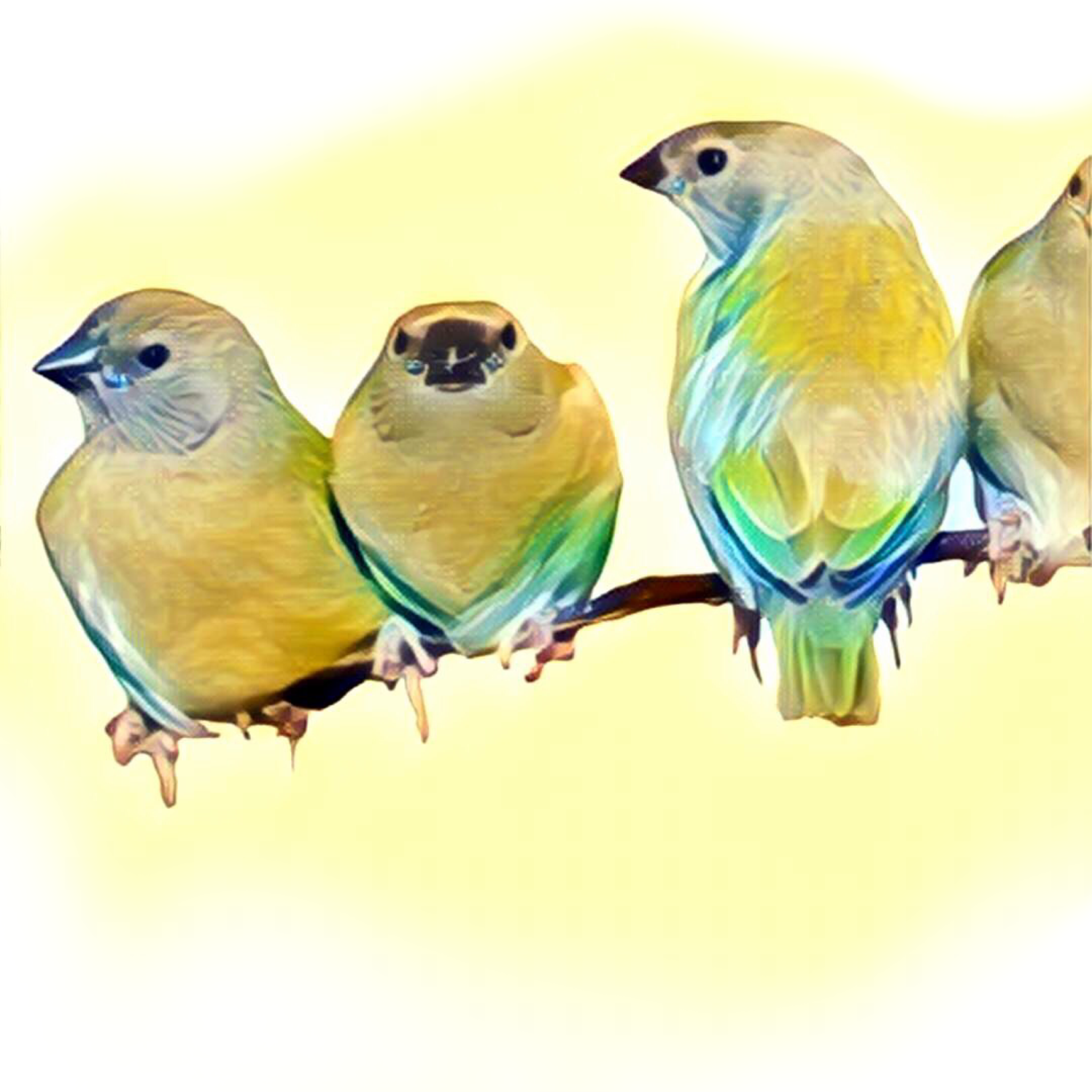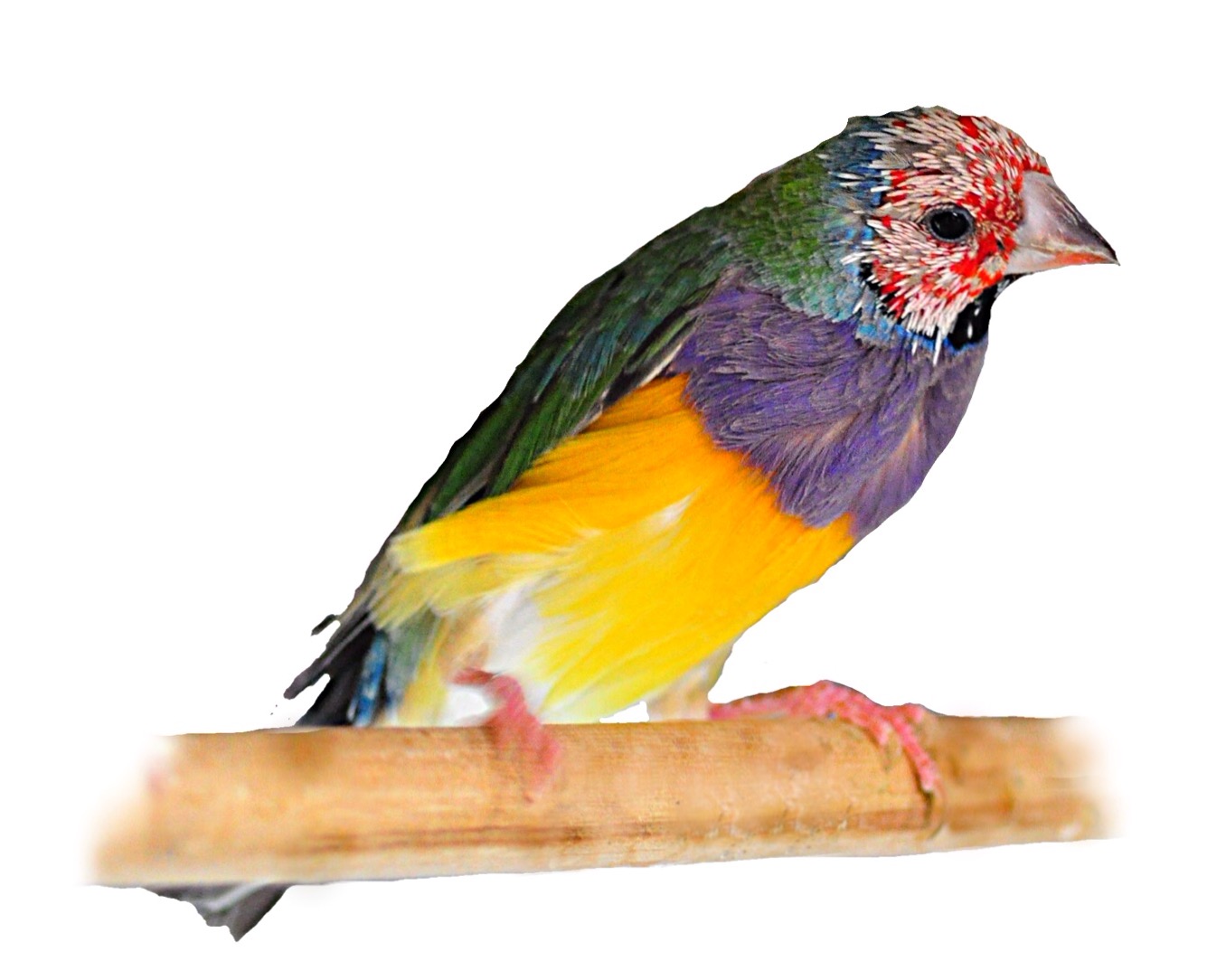Breeding Gouldian Finches
Breeding Gouldian finches is not difficult and with a little information I think you may have success as I have.

Selecting Breeding Pairs
Pairs should be selected weighing in several factors. First you must be honest with yourself and determine if you have the space and ability to raise and find good homes for the birds your going to be producing. Second must have a good understanding of genetics so that you produce the birds that you want and most importantly improve the breed. If your desire is to simply put two birds together to watch them hatch out chicks then I’d strongly encourage you to experiment on a species that is not threatened in the wild. Gouldians in Australia are a threatened species so it is essential that captive raised birds are of the highest quality and health.
Moving forward
Once you determine you have the knowledge, space and connections to re-home the birds you will then need to select a breeding pair. The cock bird should be a good size, not small or underdeveloped. His feathering should be radiant, perfect and smooth. If his feathers appear dull and uneven then he either may not be done with his molt or is a poor specimen. The posture of the bird should be upright and strong, and finally the bird should be very active. Once you find a male you will need to select a female. Females should have all the characteristics of the male except of course the color of her feathers naturally will be more muted.
How I like to pair birds
I have flock of 25 hens and 25 cocks, and each year after the young birds have fully weaned I select the best birds to move forward with breeding. I keep all my breeding birds in sexed divided flight cages. They stay here until they are ready to breed in late December. Since the flight is divided and the opposite sex cannot see each other it makes pairing birds much easier as they do not select their own mates beforehand.
I keep careful breeding records and if pairs have previously proven to be productive I will pair them year after year. Think of it this way if you enjoyed being paired with a certain mate wouldn’t you more happily take on the burden of nesting and raising young? birds are no different. They have preferences that we cannot always see. If a pair produces what you want and are highly compatible, don’t ruin a good thing. New birds are paired up with mates of my choosing and then I watch and observe.
Compatibility
If a pair is really compatible it won’t take long for the male to sing and dance for the female. She should respond by tilting her tail toward the male. Also at night I will peak in and look to see if the pair is sleeping next to each other. If they are on opposite sides of the cage then that clearly indicates they are not compatible. Breeding Gouldian Finches is not always easy. Sometimes it works well to introduce two hens into a cage with a male that has had about a week to acquaint himself with the cage and the partially stuffed nest box. The hen the male most favors will be the one he courts the most and sleeps next to.

Eggs
Once you match together a compatible pair. They should start producing eggs within two weeks. One egg per day will be laid until a clutch of 4-8 eggs are produced. It is best to not disturb the birds during this phase. During this time the nutritional diet for the female is essential. Sterilized eggshell or oyster shell are a must to ensure she has adequate calcium to keep her bones tapped up.
One thing to to keep in mind is that breeding Gouldian Finches comes with some risks. Female birds metabolize calcium from their bones and so the calcium she eats today is not necessarily the calcium she uses to coat her eggs tomorrow. Birds kept indoors where they do not have exposure to full UVB light can quickly develop calcium deficiency and this is what causes egg binding in hens. If the birds do not have vitamins D3 they cannot motabolize the calcium they eat. Make sure you provide a calcium supplement along with the egg shells that contain vitamin D3. Hens can quickly die from this condition so get into a routine ahead of he breeding season.
Moisture is a must
Humidity is also a very important aspect of incubation when breeding Gouldian finches. During the winter with a furnace running the humidity indoors often is no more than 20-30%. Eggs need about 60% at the lowest for the embryo to properly develop and hatch. In the past I ran into issues with dead in shell due to inadequate humidity in the bird room. The other thing you can do is supply a water bowl for the birds to bath in and they will wet their feathers down to regulate the humidity themselves.
No peeking!
I typically do not like to check the eggs but one time towards the end of incubation period just to check the fertility and the amount of airspace in the egg. Checking anymore than this can cause the birds to abandon their eggs or toss the chicks when they hatch. Make sure you purchase a nest box that allows you to access the eggs from the outside of the cage with minimal disturbance to the parent birds.

Chicks
Once the chicks hatch, usually on the 13-15th day you will hear faint peeping. At this time you need to make sure you always keep food available. Parent birds may toss babies if they feel the food supply is inadequate. I like to place sprays of millet in the cage the day the chicks hatch. The second day I then start offering sprout seed and egg food. I also keep dehydrated egg food available at all times. The egg food I use is produced by CeDe it is very high quality and room temperature safe. Some breeders only use this product and do not bother with sprout seed or fresh egg food. They produce many healthy young just on this alone. I personally feel that the birds enjoy the option to choose for themselves. The parents will feed the babies in the nest for approximately 20 days. Their growth will be rapid and the crop should always appear full and plump with seed. Again do not peek too often, just enough to make sure they are being fed.

Juvenile Molt
The juvenile molt is one of the most stressful times in a gouldians life. If they are not managed properly during this time many often do not survive. Lets consider some of the main factors that contribute to juvenile mortality. Young birds have a very delicate immune system. It is unnatural for birds to be kept in small confined cages. This action invariably exposes the young birds to fecal contamination. No matter how clean you try to keep the cages, young birds are very curious by nature and pick at anything. The main diseases that commonly impact gouldian young are coccidiosis and general protozoan infections. You can take your chances and not do anything about it, but you will eventually have losses from this disease.
You can reduce your losses to nearly zero!
I have developed a preventative treatment plan for breeding Gouldian finches that eliminates the risk of these terrible protozoan diseases. Begin treating the young the moment they emerge from the nest! Treat in drinking water using Ronivet S, and Trimethoprim Sulfa. You can also use Endocox instead of Trimethoprim, both work very effectively from my experience. This does not reduce the development of the young birds immune system, but instead enhances it. Treating the bird 5 days on and two days off until they have completed their juvenile molt. This may seem extreme and I know many will consider this to be abusing the use of medication. I however have seen the true benefits to protecting the young birds immune system so that they can focus on growth and development. Once the critical stage of the Juvenile molt has passed they can be treated three to four times a year afterwords.
Other things to consider
When breeding Gouldian finches you need to ensure that you supply a high quality diet until they have fully molted. Egg food with sprouted seeds will be the main staple. Include quality greens like broccoli, shredded carrot, kale, and bok choy. I personally find using a food processor is important to get the leaves small enough for them to eat. I also make sure I supply a good mineral and vitamin supplement in the water throughout this period. Make sure that the temperature is stable but warm. Young gouldian birds molt quickly when the temperature is close to 80 degrees. Timing when you have young birds and warm temperatures are vital to a quick molt. You want to be breeding Gouldian finches at a certain time so that the juvenile birds can finish molting as the temperatures naturally warm up in the spring into summer.


